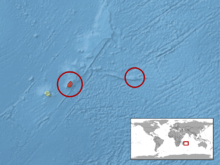Blue-tailed day gecko
| Blue-tailed day gecko | |
|---|---|
 | |
| Scientific classification | |
| Kingdom: | Animalia |
| Phylum: | Chordata |
| Subphylum: | Vertebrata |
| Class: | Reptilia |
| Order: | Squamata |
| Suborder: | Sauria |
| Infraorder: | Gekkota |
| Family: | Gekkonidae |
| Subfamily: | Gekkoninae |
| Genus: | Phelsuma |
| Species: | P. cepediana |
| Binomial name | |
| Phelsuma cepediana (Milbert, 1812)[1] | |
 | |
The blue-tailed day gecko (Phelsuma cepediana Merrem, 1820) is a diurnal species of gecko, which is endemic to the island Mauritius. It typically inhabits warm and humid places and dwells on different trees and bushes.
Etymology
The specific name, cepediana, is in honor of French naturalist Bernard Germain de Lacépède.[2]
Scientific synonyms
- Phelsuma inunguis Cuvier, 1817
- Platydactylus Cepedianus A.M.C. Duméril & Bibron 1836: 301
- Phelsuma trilineatum Gray, 1842
- Phelsuma cepedianum Angel, 1942: 29
- Phelsuma trilineata Raxworthy & Nussbaum, 1993
- Phelsuma cepediana Kluge, 1993
- Phelsuma cepediana Glaw & Vences, 1994: 297
- Phelsuma cepediana Rösler, 2000: 101
Description

P. cepediana belongs to the middle-sized day geckos. It can reach a total length (including tail) of about 15 centimetres (5.9 in). There always is a dorso-lateral stripe present, which may be broken. A red stripe extends from the nostril to the shoulder. The male body colour is light green or bluish green. The backs of males have a bright blue colour and are covered with dark red spots and dashes. The males have deep blue tails. Females lack the brilliant blue colour of the males. They have a bright green back and rust-coloured spots.
Distribution
The blue-tailed day gecko inhabits the island Mauritius where it is widely distributed. P. cepediana may also have been introduced to Madagascar where it has been reported a few times, amongst others in the region of Iviloina. These observations have not been confirmed though.
Habitat
P. cepediana is mainly found on bushes and trees such as coconut palms, traveler's palms, banana trees and papayas. They also inhabit gardens and houses in suburban areas. These geckos prefer a moist and warm climate. McKeown (1993) mentions that the original vegetation of Mauritius has been largely replaced with agricultural crops where these day geckos cannot live.
Diet
Blue-tailed day geckos feed on various insects and other invertebrates. They also like to lick soft, sweet fruit, pollen and nectar. The flowers of the now critically endangered liana Roussea simplex produce copious amounts of nectar and are pollinated only by the blue-tailed day gecko. The blue-tailed gecko later on plays a role by lincking up a gelatinous substance secreted by the fruit which contains the minute seeds. It disperses the seeds in its droppings. Regrettably, the 2 mm long ant Technomyrmex albipes that was introduced to Mauritius from the Indo-Pacific area seal the flowers of Roussea with clay to protect mealy bugs. These drink the sap and excrete a sugary urine that is collected by the ants. The ants attack animals that visit the plant, and so prevent the blue-tailed day gecko from pollinating the flowers and eating from the fruit, and in this way seriously hampering Roussea's reproduction.[3]
Behavior
This Phelsuma species can be quite aggressive both toward their own and to other Phelsuma species. In captivity, where the females cannot escape, the males can also sometimes seriously wound a female. In this case the male and female must be separated.
Reproduction
The females lay their eggs in a protected location. These Phelsumas glue their eggs. At a temperature of 28 °C (82 °F), the young will hatch after approximately 40–45 days. The juveniles measure 40 millimetres (1.6 in).
Care and maintenance in captivity
These animals should be housed in pairs and need a large, well planted terrarium. It is important to provide the terrarium with sufficient air flow. The temperature should be between 28 and 30 °C (86 °F). The humidity should be maintained between 75 and 100. In captivity, these animals can be fed with crickets, wax moth, fruits flies, mealworms and houseflies.
References
- ↑ "Phelsuma cepediana ". The Reptile Database. www.reptile-database.org.
- ↑ Beolens, Bo, Michael Watkins and Michael Grayson (2011). The Eponym Dictionary of Reptiles. Baltimore: Johns Hopkins University Press. xiii + 296 pp. ISBN 978-1-4214-0135-5. (Phelsuma cepediana, p. 149).
- ↑ "Roussea simplex". Kew Royal Botanic Gardens. Retrieved 2016-03-17.
Further reading
- Christenson, Leann, and Greg Christenson (2003). Day Geckos In Captivity. Ada, Oklahoma: Living Art Publishing. pp. 123–124. ISBN 0-9638130-2-1.
- Henkel, F.-W., and W. Schmidt (1995). Amphibien und Reptilien Madagaskars, der Maskarenen, Seychellen und Komoren. Ulmer Stuttgart. ISBN 3-8001-7323-9
- McKeown, Sean (1993). The general care and maintenance of day geckos. Advanced Vivarium Systems, Lakeside CA.